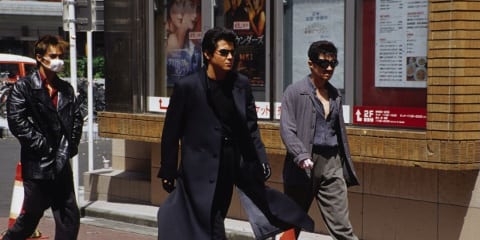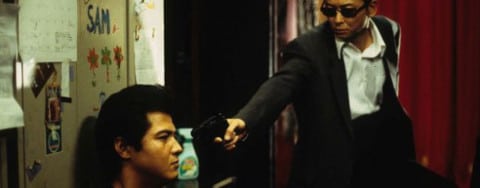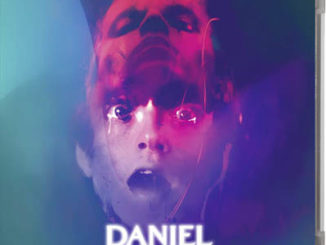Dead or Alive (1999)
Directed by: Takashi Miike
Written by: Ichiro Ryu
Starring: Hitoshi Ozawa, Renji Ishibashi, Riki Takeuchi, Shô Aikawa
AKA DEDDO OA ARAIBU: HANZAISGA
Japan
AVAILABLE ON DUAL FORMAT BLU-RAY AND DVD: NOW, from ARROW VIDEO, in the DEAD OR ALIVE TRILOGY BOXSET
RUNNING TIME: 105 min
REVIEWED BY: Dr Lenera, Official HCF Critic

In Tokyo’s Shinjuku district, a large number of Japanese and Chinese gangsters are massacred at a time when the Yakuza and the Triads are on the verge of reaching a historic truce. Behind the killings is ruthless, ambitious gangster Ryuichi who is trying to take over the underworld. His younger brother Toji returns from American and is horrified to find out that not only is Ryuichi a savage killer but also that blood money paid for his education. Meanwhile Detective Jojima’s investigations into the gang war are compromised by his need of $200,000 to pay for a life-saving operation for his daughter….
I was most pleased after watching and reviewing Takashi Miike’s Black Society Trilogy: Shinjuju Triad Society, Rainy Dog, and Ley Lines, to be reminded that the crazy Japanese cult director’s next trilogy of movies – the Dead Or Alive Trilogy which comprises Dead Or Alive, Dead Or Alive 2: Birds and Dead Or Alive: Final – were also coming out from Arrow Video. I didn’t like everything about the first trilogy, but I did like a great deal of it and Miike seems to me to be one of those directors whom you just want to keep on exploring because his stuff, even though not at times for the easily offended as he loves to shock people and wind them up, is highly interesting and does contain a lot of qualities including unusual characters, social commentary [the first trilogy intelligently looked at Japanese/Chinese relations without ever letting it dominate the films] and unpredictability – though it’s a lengthy enterprise as the man has made so many films. The previous trilogy revolved around the criminal underworld, and so does this one. Well, it’s a perfect setting for Miike’s interests in people who live on the fringes of society and extreme violence. Dead Or Alive in some ways comes across as a variant on Shinjuku Triad Society, but more assured in its filmmaking.
It has an insane opening 7 or 8 minutes that was probably designed to weed out the weaklings and spare them from watching the rest of the film. Two men are crouching on a a river bank and one of them says ”one, two, three, four”, after which the rock music starts and we are assaulted by a lengthy montage of killings and violence interspersed with shots of a pole dancer and, as in the comparatively short and sedate montage at the beginning of Shinjuku Triad Society, cuts to a DJ spinning in a night club. We are treated to the sight of the body of a naked woman plunging from a high building to the ground below and on-lookers enveloped in her exploding bag of cocaine, a cop smashing a girl’s head into a post box, a man having his throat slashed during anal sex, and, for the piece de resistance, a man eating noodles who is shot in the stomach and the noodles are seen dripping out [though this last effect is done with poor early CGI]. I’m sure many viewers will be extremely disorientated, though the sequence is extremely well edited together and you can’t say that Miike doesn’t know what he’s doing! Plus it does actually introduce most of the main characters and the set-up. The madness then continues when the three assassins become a stage act that involves a man being tied to a wheel while a puppet gives him a blow job, which is made to go faster and faster by another guy riding a stationery bicycle, while the third man throws knives wearing traditional Japanese noh garb and pig makeup. And there are peculiar bits dotted throughout the whole film, like a meeting between three gangsters which begins as a game of Russian roulette for two of them, then at the end of the conversation the third person present puts the gun to his head and blows his brains out. Or the police chief who makes and plays flutes during meetings with his men.
However, after its adrenalin-filmed opening, Dead Or Alive then adopts quite a measured pace for pretty much the next hour or so and basically becomes a variant on Heat, with a cop trying to catch a gangster but both sharing similar traits and some grudging respect. Jojima does though become obsessed with bringing down Ryuichi, to the point where he can’t spend much time with his wife and daughter, the latter of whom may die if the money isn’t found to have an operation. The couple don’t share a bed, and father and daughter don’t even talk, but we’re not given any big speeches or arguments, something which makes the typical ‘cop has no time to be with his family’ situation seem almost fresh. That’s one thing I like about a lot of Japanese films: screenwriters and directors are often content to just sketch things out and let the viewer fill in the details – another example here is Ryuichi and his girlfriend. Meanwhile Ryuichi has a brother who can’t decide whether he wants to be a gangster or not. A robbery occurs, and Jojima knows that Ryuichi is behind it but cannot actually prove it. Killings begin anew, betrayals occur and tragedy happens which probably won’t be a surprise to many, but there’s an emphasis on dialogue – some of which is quite philosophical about life and death, and relationships, even if we don’t feel too much for the characters when people close to them are killed, the cold, distancing effect of the film increased by the way the camera seems to want to keep back, with lots of long static shots. One dialogue scene is shot from the other side of the road from the characters with vehicles constantly streaming past. And, interestingly, characters very rarely seem to say what they want to say, a notable touch.
The racial undertones of the films in the Black Society Trilogy are continued though only in a few scenes, and the themes of family and loyalty are present too. Again, these people tend to be outcasts, though their lives are more open. I should warn you right now there are still some shocking moments [I’m frankly astonished at it’s ’15’ rating]. Our so-called ‘hero’ goes to get information from a pornographer who is shown as one of two men try feverishly to excite an Alsatian dog so it can mount a naked girl in their presence, and says nothing! It’s not at all an explicit scene but most filmmakers wouldn’t even have the guts to hint at something like this. I didn’t like seeing it, but you have to admire Miike for showing scenes others wouldn’t, even if most of the time it just seems like a childish attempt to shock more than anything else. There’s also a drowning in a swimming pool filled with the raped victim’s own poo [though on-screen sexual violence is nicely missing from this film] which really will make you feel sick, and partly because it’s artistically shot. Is there a point to all this? Probably not, except for the idea that maybe Miike is trying to show the ugly truth about a lifestyle often glamorised in movies by exaggerating. You could say that it detracts attention from the themes of Ichiro Ryu’s often quite intelligent screen play, though after the leisurely pace of much of the film, the last half hour is packed with violence which gets increasingly cartoonish [though John Woo would have loved the feathers flying around during a gun battle] and over the top – and which finally ends with possibly the craziest last couple of minutes of a film I’ve ever seen. Honestly, you’ll probably sit there open mouthed and may even rewind the Blu-ray just to make sure you saw what you thought you did.
There’s lots of effective use of set design [red is especially used frequently], a few terrific individual shots like a man sitting in a chair in the middle of the frame bordered by flowers on one side and the sun streaming in through a window on the other, and one really striking locale, a gloomy graveyard in a swamp. Overall it’s a much slicker looking piece than the Black Society films while still retaining a feeling of rawness. This film paired the two superstars of Japanese V [straight to video] Cinema for the first time. Riki Takeuchi’s flashy performance as Ryuichi is matched by Sho Aikawa’s far more restrained turn, though it was maybe a little too restrained for my liking. Dead Or Alive is a film in which its two sides – the sober, intelligent drama, and the outlandish shocker – seem to be waging a war for control, but that’s Miike for you. It’s a sign of Miike’s skill as a filmmaker that he not just keeps his film from going out of control but has made a pretty good one as well.
Rating: 









Dead Or Alive looks good if not great on Blu-ray, but Arrow have still done a fine job considering the film’s video origins. The disc comes with an interview with star Riki Takeuchi which lasts over half an hour. Now head of a production company, he seems very enthusiasic as he talks about his career [he’s had 200 lead roles and has been in a series which has had 63 installments] and working with Miike, who’s cast him several times. It didn’t really surprise me to learn that Miike tends not to make his films with a full script and adds things as he goes along. He also states his opinions of the three Dead Or Alive pictures and about the Japanese film industry. He’s forthright and never dull. I do though recommend that you don’t watch it until you’ve seen the other two films as it shows some lengthy clips from them. The audio commentary by who else but Tom Mes floats along with his usual highly chilled-out delivery, but you can still tell thst he’s relishing the chance to do a talk track on the film that introduced him to Miike, as it’s one of the best ones from him I’ve heard constantly offering insight, observations and information, without a weak moment.
SPECIAL FEATURES:
DEAD OR ALIVE
*Riki Takeuchi: Deadly Outlaw Riki
*Japanese trailer
*US trailer
*Audio commentry by Miike biographer Tom Mes
DEAD OR ALIVE TRILOGY BOXSET
*High Definition digital transfers
*Optional stereo audio
*Original theatrical trailers
*Reversible sleeve featuring original and newly commissioned artwork by Orlando Arocena
*FIRST PRESSING ONLY: Illustrated collector’s booklet featuring new writing on the films by Kat Ellinger







Be the first to comment